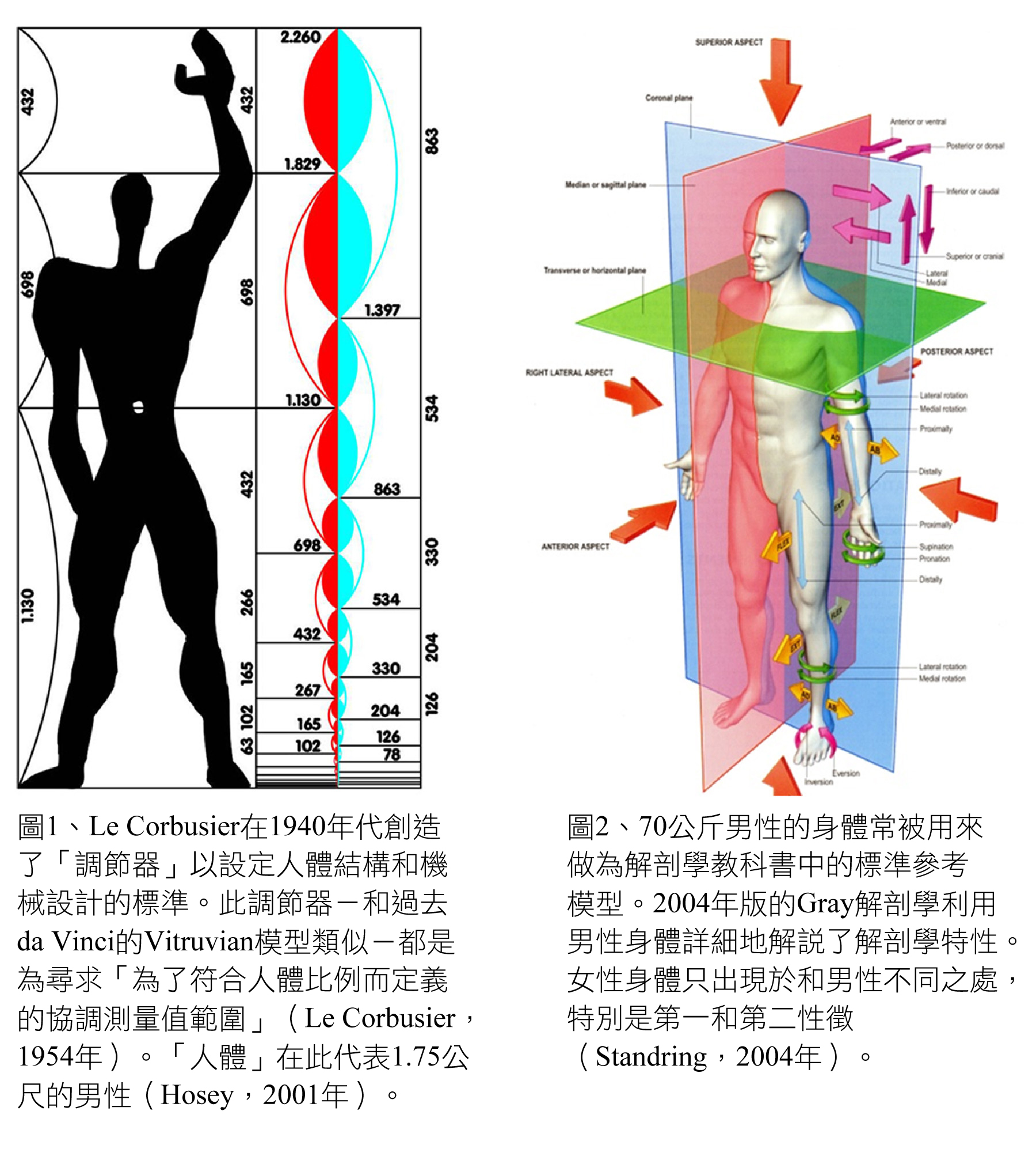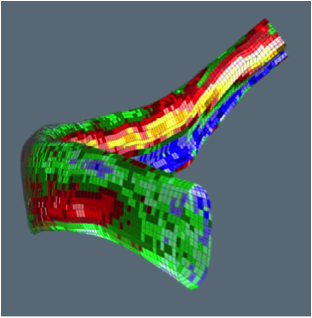
人類胸腔模型:
重新思考標準和參考模型
性別化創新方案是依歐盟委員會要求訂定,用來分析其框架計畫七(FP7) 中的幾項方案。本個案研究探討「人類胸腔和上肢的有限元素模型發展(THOMO)」方案。我們要識別性別化創新、生理性別和社會性別分析方法、和潛在「增值」點。
議題
生物擬真模型是提高汽車乘客安全性的重要工具。這種模型通常由工程師、製造商和政府機構使用。人體安全模型—— (HUMOS-1) 是由歐盟委員會框架計畫四 (FP4) 於1997至2000年間贊助。這個模型是以單一男性大體研究為主,代表「第50百分位坐式男性」 (Pajon 等人,2002)。人體安全性模型二(HUMOS-2)則是由歐盟委員會框架計畫五 (FP5) 於2002至2006年間贊助。此模型收集了整體重量第5、50、95百分位的人體測量學資料,因此對體重較輕(多為女性)和體重較重(多為男性)的人來說更具包容性 (Toma et al., Acart et al., 2009a; Dupont-Kerlan et al., 2006)。生物擬真性模型首先為第50百分位的男性而開發,因此排除個體明顯嬌小或龐大的人。
方法:重新思考標準和參考模型
人體模型一直以來都是以第50百分位的歐洲和北美男性為主 (見案例研究:具包容性的碰撞實驗假人)。研究人員正重新思考這個標準,也正在研究更廣泛的女性和男性人體,以生產更先進的和有代表性的人體模型。
性別化創新:
- 製作女性和男性胸腔模型:「人類胸腔和上肢的有限元素模型發展(THOMO)」研究人員正在發展可用於多數女性與男性的人體胸腔模型。
- 雌性與雄性一致的胸腔生物力學測試
以性別化創新方法,增加未來研究的潛在價值:
- 研究年齡和停經後狀況對胸腔骨骼結構的影響
- 包括不同地域的族群
- 製作胸部組織模型
議題
背景:歐盟框架計畫七 (FP7) 胸腔模型 (THOMO) 計畫
性別化創新 1:製作女性和男性的胸腔模型
方法:重新思考研究優先次序與結果
性別化創新 2:雌性與雄性胸腔生物力學一致性測試
方法:重新思考標準和參考模型
透過性別化創新方法的應用增加未來研究的潛在價值
潛在附加價值 1:研究年齡和停經後狀況對胸腔骨骼結構的影響
方法:交織性研究方法
潛在附加價值 2:涵蓋不同地域的族群
方法:交織性研究方法
潛在附加價值 3:胸部組織模型
方法:形成研究問題
議題
道路交通意外是歐盟和美國導致死亡和發病的主要原因之一;2009年車輛撞擊在歐盟27國造成約34,500人死亡,在美國也約造成30,862人死亡 (Eurostat, 2011; NHTSA, 2012)。這類死亡通常集中於男性。在歐盟和美國,男性於車禍中死亡的機率較女性高出約2.6倍 (DG Energy and Transport, 2009; Kposowa et al., 2009)。
為了提高工程的安全性,許多研究計畫被用來開發人體有限元素模型。同樣地,這些模型通常一開始是以第50百分位男性的人體測量學資料為主,後來擴大到包含較大和較小體型的模型 (Yang et al., 2006)。依照這種模式,由歐盟委員會框架計畫四(FP4)於1997至2000年間贊助的人體安全性模型—— (HUMOS-1) 以單一男性大體研究為主,代表「第50百分位坐式男性」 (Pajon et al., 2002)。
由歐盟委員會框架計畫五 (FP5) 於2002至2006年間贊助的人體安全性模型二(HUMOS-2)則擴大收集包含第5、50和95百分位——也就是體重較輕(多為女性)和體重較重(多為男性)者的資料 (Toma et al., 2010; Acart et al., 2009a; Dupont-Kerlan et al., 2006)。然而,生物擬真模型仍然首先為第50百分位的男性而開發,從一開始就先排除個體明顯嬌小或龐大的人。其中的一個例子是全球人體模型聯盟 (GHMBC) 模型 (GHMBC, 2012)。
背景
歐盟框架計畫七 (FP7) 胸腔模型 (THOMO) 計畫主要目標是開發一個數字化的「人類胸腔和上肢的有限元素模型」(THOMO, 2012)。經由THOMO和相關研究團隊資料收集的程序可分成兩種基本類型:
以電腦斷層掃描(CT)、雷射掃描和微斷層掃描(μCT)測量胸腔骨骼(肋骨、胸骨、脊椎和軟骨的成像)(Mayeur 等人,2010)。
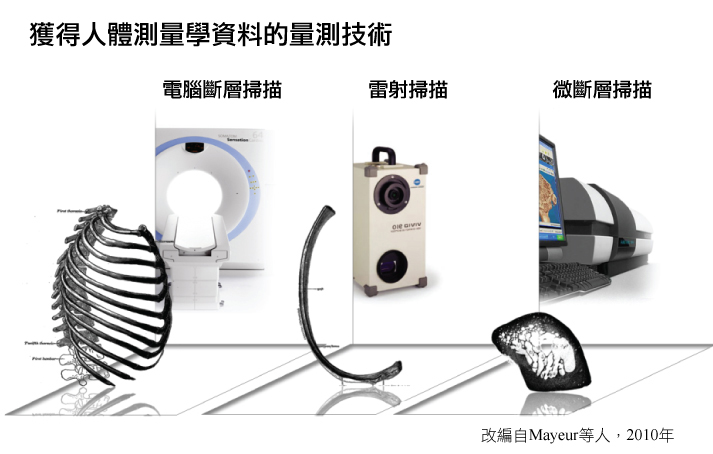
大體胸廓生物力學壓力測試。動態測試的終點包括應變和實際骨折下的變形狀況。
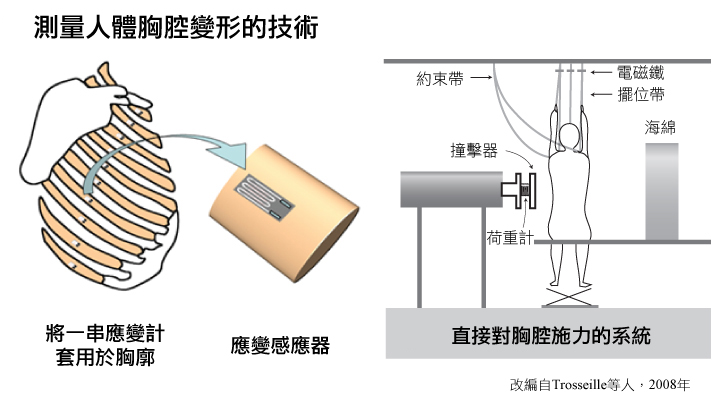
生物力學測試的目的是模擬同時來自正面和側面施加在胸腔的汽車碰撞力。測試涵蓋了各種場景,包括撞擊時繫上3點式安全帶、4點式安全帶、或未繫安全帶的駕駛/乘客,無論撞擊時是否有安全氣囊。 胸腔模型(THOMO)計畫是用來自法國的大體針對下列整個人體重量的百分位進行測量和生物力學測試:
第50百分位 (11位男性和1位女性大體)
第5百分位 (6位女性大體)
THOMO使用刻度比例製作其他百分位尺寸的模型 (THOMO, 2012)。
THOMO是歐盟車輛與道路安全行動協調聯合會(COVER) 四個生物力學模型計畫中的一個。所有的車輛與道路安全行動協調聯合會計畫都是由歐盟框架計畫七(FP7)贊助,而每個計畫都有不同的重點 (Lemmen 等人,2009) - 如下圖:
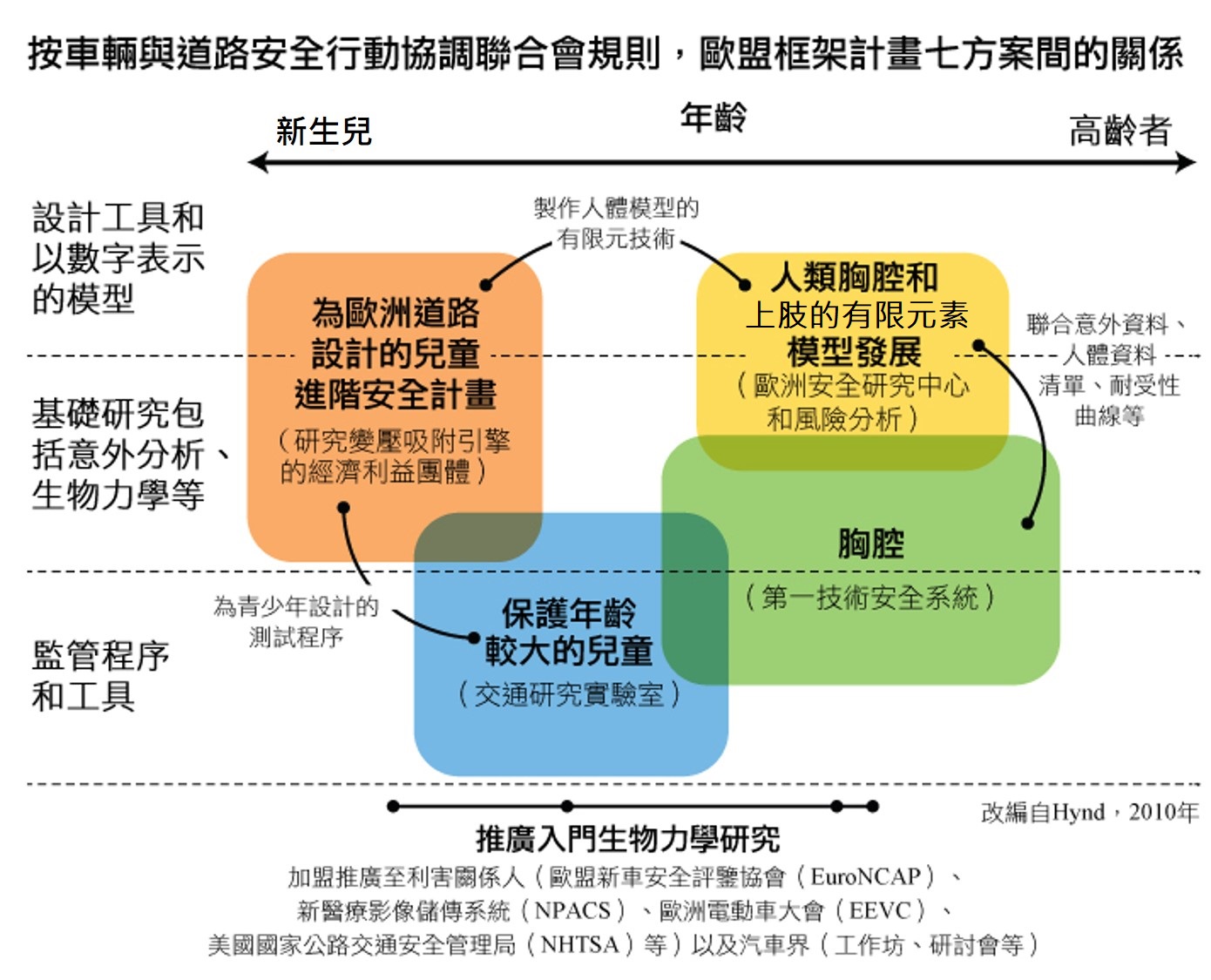
THOMO計畫是數個私人贊助之全球人體模型聯盟 (GHMBC) 專業中心之一,由來自歐盟、美國、南韓以及日本的九個汽車製造商以及美國國家公路交通安全管理局 (NHTSA) 組成 (GHBMC, 2012)。
汽車製造商為了工程安全性目的持續發展有限元素模型 (Leonardi, 2009)。其中一例是安全性的總人體模型 (THUMS),這是豐田汽車公司的專利方案 (Maeno et al., 2001)。THUMS的初始版本是以一個第50百分位美國人的人體測量學為主(Chawala et al., 2005; Oshita et al., 2002)。目前,工程師們正在擴大模型範圍,以包括第5百分位的美國女性、第95百分位美國男性和懷孕婦女 (Iwamoto et al., 2007)。
性別化創新 1:製作女性和男性的胸腔模型
THOMO計畫收集體重從第5到第50百分位的人體資料,藉此同時塑造女性與男性胸腔模型 (THOMO, 2012)。
方法:重新思考研究優先次序與結果
碰撞結果的研究顯示,當研究人員控制了身高、體重、是否使用安全帶以及撞擊程度等因子後,約有47%的女性駕駛相較於男性駕駛更容易在撞車時承受嚴重的傷害;也就是說,在同一種撞車事故中,有繫安全帶的女性駕駛,比同等身高、體重和年齡且有繫安全帶的男性駕駛,更容易受傷 (Dipan et al., 2011; Evans, 1999)。數個生理性別和社會性別因子可能影響觀察到之碰撞結果的差異:
受傷臨界值:以某些受傷機制而言,女性受傷的平均臨界值較男性低(女性比男性更易受傷),例如:(車後方被撞而引起的)揮鞭式頸部創傷,但是年輕男性的低速撞擊的受傷臨界值則比年輕女性低 (Talmor et al., 2010; Stemper et al., 2004)。
設計:女性可能因為「乘客安全裝置有效性偏向男性乘客」而有過多的風險 (Dipan et al., 2011)。
駕駛的車輛種類:從美國可取得的資料顯示,女性相較於男性更傾向駕駛高安全評等的車輛 (Ryb et al., 2010)。
性別化創新2:女性與男性胸腔生物力學一致性測試
THOMO的研究人員已在小體型胸腔模型(多數為女性胸腔)進行測試,這項測試的步驟同時與先前適用於多數男性胸腔模型之儀器和數據報告一致。這個方法可以跨越生理性別比較應變特性,也能發展出更全面性的參考模型。
方法:重新思考標準和參考模型
物理應變測試是開發生物擬真模型的關鍵。
歷史上,第50百分位男性大體胸腔模型被用來做為歐盟支持的撞擊測試之前方撞擊測試的參考 (Behr et al., 2003)。這個參考模型沒有考慮到體重較輕之人的解剖學構造,因此開發這個模型的研究人員建議用進一步的研究「為女性和高齡駕駛與乘客開發受傷風險函數」(Carroll, 2010)。第50百分位模型也遺漏了體型較大者,因此研究人員評估車輛安全性研究的「降低受傷的可能性」時,斷言「使用了大於平均體型的假人可以帶來最大好處」(Carrol et al., 2010)。THOMO的研究人員已經著手擴大超過第50百分位之胸腔模型的參考模型,其中包括涵蓋人體尺寸第5百分位的模型。有鑑於此,THOMO的研究人員已經優先考慮創造一個生物擬真性、可改變尺寸的模型,以便更完善地體現女性與男性解剖構造之差異。
透過性別化創新方法的應用增加未來研究的潛在附加價值
潛在附加價值 1:研究年齡和停經後狀況對胸腔骨骼結構的影響
胸腔個體間的差異遠超過體型和生理性別的不同。年齡和停經後狀況等因子對骨密度 (BMD) 和微架構的影響也會持續改變胸腔結構的生物力學特性。
方法:交織性研究方法
與THOMO計畫相關的因子包括:
年齡: 骨密度從出生到青春期間會緩慢增加,然後在青春期後的幾年內快速增加,並在30歲左右前達到高峰,接著會隨著年齡增加逐漸下降。生理性別的差異會影響骨密度的發展;舉例來說,由於女性青春期比男性出現較早,女性(在18-20歲)的腰椎骨密度會比男性(在20-23歲)更早達到高峰 (Boot et al., 2010)。生理性別差異也會在骨密度下降時觀察到。男性的骨密度會較早開始下降,但是女性骨密度下降的速度會比較快,特別是停經後 (Min et al., 2010; Li et al., 2003)。
大體的生物力學實驗和受傷的流行病學調查都同時說明了年齡、骨密度以及骨骼強度間的關係。從生物力學的角度來說,體積性骨密度是骨折臨界值很強大的預測因子 (Diederichs et al., 2009)。從流行病學的角度來說,「[隨年齡增加]而降低骨骼和生理彈性的後果是外傷和其後遺症,而這也是65歲或以上族群十大死亡原因之一;而車禍撞擊[…]是造成這類外傷最常見的原因」 (Gayzik et al., 2008)。
基於這些原因,對各種年齡之雌性與雄性大體進行生物力學測試可能與開發胸腔模型有關。
停經後狀況: 在女性,停經會同時導致骨密度快速流失和骨骼微結構的變化 (Sowers et al., 2010; Müller, 2005)。基於這些原因,對停經前後女性大體進行生物力學測試可能可以增加更多族群THOMO的生物擬真性。
由於可取得的大體及資源有限,這些因子在分析時可能會面臨挑戰。如果在開發期間這些因子無法完全與THOMO模型結合,可以在確認模型的有效性時考慮進去。
潛在附加價值 2:涵蓋不同地域的族群
研究人員可以用THOMO模型的百分位尺寸反映體重。雖然平均體重有生理性別差異,但生理性別並非體重唯一、也不必然是最重要的預測因子。體重差異會因國家而有所不同,研究各種大體可能可以擴大THOMO模型的應用性。
方法:交織性研究方法
不同國家間體重的系統性比較是相當具有挑戰性的。多數資料庫只記錄身體質量指數(BMI)而非體重本身,因為對於肥胖和營養不良流行病學,BMI是較佳的指標 (Finucane et al., 2011)。不過,現存的數據顯示不同國家間的實質體重的確有所不同,而且國家的差異性還比生理性別差異性顯著。舉例來說,美國男性平均比美國女性重16% (Ogden et al., 2004);而韓國男性平均比韓國女性重21% (Nam-Kyu, 2009)。假設美國和韓國的生理性別比例相同,美國人平均比韓國人重29%。事實上,美國女性平均體重(74公斤)大於南韓男性平均體重 (69 公斤) (Nam-Kyu, 2009; Ogden et al., 2004)。
潛在附加價值 3:胸部組織模型
研究人員可能可以透過檢查關於胸部組織於車輛撞擊受傷時之重要性的研究問題,提高生物擬真性。
方法:形成研究問題
胸部組織在兩方面很重要:首先是胸部直接受傷;其次是安全帶擺位的差異可能擴大了撞擊安全性的效果。
- 車輛撞擊時胸部的傷害
安全帶的使用大大地增加了乘客在撞擊時的安全性,但是三點式安全帶造成的壓迫力和剪應力可以引起特定的胸部傷害,包括胸部組織的損壞,雖然這種情況很稀少 (Paddle et al., 2009)。胸部組織的傷害範圍嚴重程度從輕微的撞擊傷伴隨有瘀青,到嚴重的胸部外傷,甚至胸部組織從胸廓撕裂,並有因肋骨間血管破裂而造成的內出血狀況 (Paddle et al., 2009)。 胸部傷害可能造成乳腺斷裂,因而成為哺乳女性特別關注的議題 (Sircar et al., 2010)。有乳房植入物的女性也應特別關注(Gatta et al., 2006)。 胸部區域軟組織的傷害並非女性特有。Mondor氏病—因胸廓靜脈受損所造成—同時有繫上安全帶的女性與男性病人於撞擊後發生此狀況的個案報告 (Gatta et al., 2006)。- 胸部和安全帶的擺位
某些女性會因為肩膀上的安全帶擺位跨越胸部造成的不適而不當穿戴安全帶。安全帶不當使用會大大增加整體的撞擊時受傷的風險 (Nordhoff, 2005)。 懷孕時,「人體測量學的變化遍布全身,而不會只侷限於腹部區域」,而且胸部尺寸的變化「因為會影響安全帶的貼身性和擺位而變得特別重要」(Acar et al., 2009)。安全帶的設計能容納非懷孕女性腹部深度至第95百分位,卻沒有考慮到62%妊娠末三個月女性大腹便便的狀況 (Acar et al., 2009a)。研究人員主動開發有限元模型以改善懷孕婦女的乘車安全 (Acar et al., 2009b) (見案例研究: 具包容性的碰撞實驗假人)。
參考資料
Acar, B., Weekes, A., & Van Lopik, D. (2009a). 'Expecting': Occupant Model Incorporating Anthropometric Details of Pregnant Women. International Journal of Vehicle Design, 51 (3-4), 374-385.
Acar, B., & Van Lopik, S. (2009b). Computational Pregnant Occupant Model, 'Expecting,' for Crash Simulations. Journal of Automobile Engineering, 223 (7), 891-902.
Anderson, P. (2008). Reducing Drinking and Driving in Europe. Hamm: Deutsche Hauptstelle für Suchtfragen e.V. (DHS)
Banerjee, A. (1989). Seat Belts and Injury Patterns: Evolution and Present Perspectives. Postgraduate Medical Journal, 65 (762), 199-204.
Basic Research in Industrial Technologies for Europe (BRITE) - European Academy of Management (EURAM). (2001). Research: Making a Lasting Impression on Europe.
Behr, M., Arnoux, P., Serre, T., Bidal, S., Kang, H., Thollon, L., Cavallero, C., Kayvantash, K., & Brunet, C. (2003). A Human Model for Road Safety: From Geometrical Acquisition to Model Validation with Radioss. Computer Methods in Biomechanics and Biomedical Engineering, 6 (4), 263-273.
Boot, A., de Ridder, M., Van Der Sluis, I., Van Slobbe, I., Krenning, E., & de Muinck Keizer-Schrama, S. (2010). Peak Bone Mineral Density, Lean Body Mass, and Fractures. Bone, 46 (2), 336-341.
Chawala, A., Mukherjee, S., Mohan, D., & Jain, S. (2005). Validation of the Cervical Spine Model in THUMS. New Delhi: Indian Institute of Technology.
Ciarlet, P., & Ayache, N. (Eds.) (2004). Handbook of Numerical Analysis, Volume XII: Computational Models for the Human Body. Amsterdam: Elsevier.
Cummings, P. (2002). Association of Driver Air Bags with Driver Fatality: A Matched Cohort Study. British Medical Journal, 324 (7346), 1119-1122.
Department of Trade and Industry (DTI). (1998). AdultData: The Handbook of Adult Anthropometric and Strength Measurements - Data for Design Safety. London: United Kingdom DTI.
Geometrical Acquisition to Model Validation with Radioss. Computational Methods in Biomechanics and Biomedical Engineering, 6 (4), 263-273.
Bell, S., Mederios-Ward, N., & Strayer, D. (2011). "Feminine Gender Role Constructs and Aggressive Driving Behaviors." Proceedings of the 55th Annual Meeting of the Human Factors and Ergonomics Society, September 19th-23rd, Las Vegas.
Carrol, J., Smith, S., Richards, D., & Ganu, C. (2010). Estimate of Injury Reduction Potential for Different Occupant Sizes and Ages, and Total Benefit Expected to Arise from the Project. Brussels: European Commission. PDF
Carroll, J. (2010). "Thoracic Injury Assessment for Improved Vehicle Safety: Frontal Impact Information." 13th Annual Meeting of the Global Road Safety Partnership (GRSP) Informal Group on Frontal Impacts, June 27th, Paris.
Diederichs, G., Link, T., Kentenich, M., Schwieger, K., Huber, M., Burghardt, A., Majumdar, S., Rogalla, P., & Issever, A. (2009). Assessment of Trabecular Bone Structure of the Calcaneus using Multi-Detector CT: Correlation with μCT and Biomechanical Testing. Bone, 44 (5), 976-983.
Dipan, B., Segui-Gomez, M., & Crandall, J. (2011). Vulnerability of Female Drivers Involved in Motor Vehicle Crashes: An Analysis of US Population at Risk. American Journal of Public Health, 101 (12), 2368-2373.
Dupont-Kerlan, E., Guyot, H., Josefson, L., Gubbi, F., Arnadeau, F., Laurent, M., Funk, H., Chaillou, V., Rams, J., Pries, H., Aumuller, D., Jacques, G., Folkesson, H., & Klumper, T. (2006). Human Model for Safety 2 (HUMOS 2) Project.
European Road Safety Observatory (ERSO). (2010a). Traffic Safety, Basic Facts: Gender. Brussels: European Commission.
European Road Safety Observatory (ERSO). (2010b). Traffic Safety, Basic Facts: Motorcycles and Mopeds. Brussels: European Commission.
Evans, L. (1999). "Age Dependence of Female to Male Fatality Risk in the Same Crash: An Independent Reexamination." Proceedings of the 43rd Annual Meeting of the Association for the Advancement of Automotive Medicine, September 20-21, Barcelona.
European Union Directorate-General (DG) for Energy and Transport. (2009). Panorama of Transport. Brussels: European Commission.
Eurostat. (2011). Table TRSDR420: People Killed in Road Accidents. Brussels: European Commission.
Finucane, M., Stevens, G., Cowan, M., Danaei, G., Lin, J., Paciorek, C., Singh, G., Guitierrez, H., Lu, Y., Bahalim, A., Farzadfar, F., Riley, L., & Ezzati, M. (2011). National, Regional, and Global Trends in Body-Mass Index since 1980: Systematic Analysis of Health Examination Surveys and Epidemiological Studies with 960 Country-Years and 9.1 Million Participants. The Lancet, 377 (9765), 557-567.
Gatta, G., Pinto, A., Romano, S., Anacona, A., Scaglione, M., & Volterrani, L. (2006). Clinical, Mammographic, and Ultrasonographic Features of Blunt Breast Trauma. European Journal of Radiology, 59 (3), 327-330.
Global Human Body Models Consortium (GHMBC). (2012). Status of the GHMBC Project. PDF
Hayzik, F., Yu, M., Danelson, K., Slice, D., & Stitzel, J. (2008). Quantification of Age-Related Shape Change of the Human Rib Cage through Geometric Morphometrics. Journal of Biomechanics, 41 (7), 1545-1554.
Handel, N., Hayden, B., Jervis, W., & Maxwell, P. (2000). Revisions in Breast Augmentation. Aesthetic Surgery Journal, 20 (2), 141-148.
Hynd, D. (2010). THORAX Stakeholder Workshop Dummy Demonstrator Requirements. Brussels: European Commission.
Iwamoto, M., Nakahira, Y., Tamura, A., Kimpara, H., Watanabe, I., & Miki, K. "Development of Advanced Human Models in THUMS." Proceedings of the 7th European Livermore Software (LS-DYNA) User's Conference, May 29-30, Gothenburg.
Kim, S., Depue, L., Spence, L., & Reine, J. (2009). Analysis of Teenage Seat Belt Use: From the 2007 Missouri High School Seat Belt Survey. Journal of Safety Research, 40 (4), 311-316.
Kposowa, A., & Breault, K. (2009). Motor Vehicle Deaths Among Men: Marital Status, Gender, and Social Integration. International Journal of Men's Health, 8 (2), 129-142.
Lemmen, P., & Weide, M. (2009). Coordination of Vehicle and Road Safety Initiatives (COVER) Newsletter, Issue I. PDF
Leonardi, P. (2009). From Road to Lab to Math: The Co-Evolution of Technological, Regulatory, and Organization Innovations for Automotive Crash Testing. Social Studies of Science, 40 (2), 243-274.
Li, G., Braver, E., & Chen, L. (2003). Fragility versus Excessive Crash Involvement as Determinants of High Death Rates per Vehicle-Mile of Travel among Older Drivers. Accident Analysis and Prevention, 35 (2), 227-235.
Majeski, J. (2007). Shoulder Restraint Injury of the Female Breast. International Surgery, 92 (2), 99-102.
Mayeur O., Chaari F., Delille R., Guillemot H., & Drazetic, P. (2010). Virtual Human Thorax Model Reconstruction: From Medical Imaging to Finite Element Model. International Research Council on Biomechanics of Injury Conference. Hannover, Germany.
Min, J., Min, K., Paek, D., Kang, D., & Cho, S. (2010). Age Curves of Bone Mineral Density at the Distal Radius and Calcaneus in Koreans. Journal of Bone and Mineral Metabolism, 28 (1), 94-100.
Mroz, K., Bostrom, O., Pipkorn, B., Wismans, J., & Brolin, K. (2010). "Comparison of Hybrid III and Human Body Models in Evaluating Thoracic Response for Various Seat Belt and Airbag Loading Conditions." Proceedings of the International Research Council on the Biomechanics of Injury (IRCOBI) Conference, September 15-16, Hanover.
Müller, R. (2005). Long-Term Prediction of Three-Dimensional Bone Architecture in Simulations of Pre-, Peri-, and Post Menopausal Microstructural Bone Remodeling. Osteoporosis International, 16 (S2), S25-S35.
Myhre, A., Pohlman, T., & Dee, K. (2002). Hemorrhage into the Breast in a Restrained Driver After a Motor Vehicle Collision. American Journal of Roentgenology, 179 (3), 690.
Nam-Kyu, B. (2009). Average Korean Now Overweight. The Chosun Ilbo (English Edition)—Daily News from Korea, July 27.
Noordzij, P., Forke, E., Brendicke, R., & Chinn, B. (2001). Integration of Needs of Moped and Motorcycle Riders into Safety Measures. Brussels: European Commission.
Nordhoff, L. (2007). Biomechanics: A Primer for Motor Vehicle Collision Injuries. Plaintiff Magazine, November, ¬1-7.
Nordhoff, L. (2005). Motor Vehicle Collision Injuries: Biomechanics, Diagnosis, and Management. London: Jones and Bartlett Publishers International.
Ogden, C., Fryar, C., Carrol, M., & Flegal, K. (2004). Mean Body Weight, Height, and Body Mass Index, United States, 1960-2002. Centers for Disease Control (CDC) Advance Data from Vital and Health Statistics, 347, 1-18.
Oshita, F., Omori, K., Nakahira, Y., & Miki, K. (2002). "Development of a Finite Element Model of the Human Body." Proceedings of the 7th International Livermore Software (LS-DYNA) User's Conference, May 19-21, Dearborn, Michigan.
Paddle, A., & Morrison, W. (2009). Seat Belt Injury to the Female Breast: Review and Discussion of its Surgical Management. Australia, New Zealand (ANZ) Journal of Surgery, 80 (1-2), 71-74.
Pajon, M., Kallieris, D., Dejeammes, M., Thunnissen, J., Ostmann, M., Mack, P., Baldauf, H., Keflas, V., Lovsund, P., Reis, O., Chabert, L., Strehi, D., Eberhard, H., & Bonnoit, J. (2002). Geometric Data Base of a 50th Percentile Seated Man and 3D Reconstruction. Brussels: European Commission.
Pajon, M., Kallieris, D., Dejeammes, M., Thunnissen, J., Ostmann, M., Mack, P., Baldauf, H., Keflas, V., Lovsund, P., Reis, O., Chabert, L., Strehi, D., Eberhard, H., & Bonnoit, J. (2000). Human model for Safety.
Procher, V., & Vance, C. (2012). Heterogeneity in the Correlates of Motorized and Non-Motorized Travel in Germany – The Intervening Role of Gender. Social Science Research Network Ruhr Economic Paper 314.
Robin, S. (2001). "HUMOS: Human Model for Safety—A Joint Effort towards the Development of Refined Human-Like Car Occupant Models." United States Department of Maeno, T., & Hasegawa, J. (2001). Development of a Finite Element Model of the Total Human Model for Safety (THUMS) and Application to Car-Pedestrian Impacts. Aichi: Toyota Motor Corporation.
Ryb, G., Burch, C., Kerns, T., Dischinger, P., & Ho, S. (2010). Crash Test Ratings and Real-World Frontal Crash Outcomes: A Crash Injury Research Engineering Network (CIREN) Study. Trauma and Acute Care Surgery, 68 (5), 1099-1105.
Sircar, T., Mistry, P., Harries, S., Clarke, D., & Jones, L. (2010). Seat-Belt Trauma of the Breast in a Pregnant Woman Causing Milk-Duct Injury: A Case Report and Review of the Literature. Annals of the Royal College of Surgeons of England, 92 (5), W14-W15.
Sowers, M., Zheng, H., Jannausch, M., McConnell, D., Nan, B., Harlow, S., & Randolph, J. (2010). Amount of Bone Loss in Relation to Time around the Final Menstrual Period and Follicle-Stimulating Hormone Staging of the Transmenopause. Journal of Clinical Endocrinology and Metabolism, 95 (5), 2155-2162.
Stemper, B., Yoganandan, N., & Pintar, F. (2004). Gender- and Region-Dependant Local Facet Joint Kinematics in Rear Impact: Implications in Whiplash Injury. Spine, 29 (16), 1764-1771.
Talmor, D., Legedza, A., & Nirula, R. (2010). Injury Thresholds after Motor Vehicle Crash—Important Factors for Patient Triage and Vehicle Design. Accident Analysis and Prevention, 42 (2), 672-675.
Toma, M., Njilie, T., Ghajari, M., & Galvanetto, U. (2010). Assessing Motorcycle Crash-Related Head Injuries using Finite Element Simulations. International Journal of Simulation and Modeling, 9 (3), 143-151.
Transportation (US-DOT) National Highway Traffic Safety Administration (NHTSA) 17th International Technical Conference on the Enhanced Safety of Vehicles, June 4th-7th, Amsterdam, Paper # 297.
Tropiano, P., Thollon, L., Huang, R., Kayvantash, K., Poitout, D., & Brunet, C. (2004). Using a Finite Element Model to Evaluate Human Injuries: Application to the HUMOS Model in Whiplash Simulation. Spine, 29 (16), 1709-1716.
Trosseille, X., Baudrit, P., Leport, T., & Vallancien, G. (2008). Rib Cage Strain Pattern as a Function of Chest Loading Configuration. Stapp Car Crash Journal, 52, 205-231.
United States Department of Transportation (US-DOT) Federal Highway Administration (FHWA). (2007). Highway Statistics 2006: Licensed Drivers by Sex and Ratio to Population, Table DL-1C.
United States Environmental Protection Agency (US-EPA). (2009). Exposure Factors Handbook. Washington, D.C.: Government Publishing Office (GPO).
United States National Highway Traffic Safety Administration (NHTSA). (2012). Fatality Analysis Reporting System (FARS) Encyclopedia.
Verriest, J. (2006). Achievements of HUMOS2 project (Human Model for Safety). Washington, D.C.: National Academies Press Transportation Research Board.
Vezin, Dider, A., & Berthet, F. (2010). Characterization of the 3D Deformation of the Human Rib Cage for the Analysis of Injury Mechanism: An Experimental and Modeling Coupled Approach. PDF
Vezin, P, & Verriest, J. (2005). "Development of a Set of Numerical Human Models for Safety." Proceedings of the 19th International Technical Conference on the Enhanced Safety of Vehicles, June 6-9, Washington, D.C.
World Health Organization (WHO). (2007). Drinking and Driving: A Road Safety Manual for Decision-Makers and Practitioners. Geneva: Global Road Safety Partnership.
Yang, K., Hu, J., White, N., King, A., Chou, C., & Prasad, P. (2006). Development of Numerical Models for Injury Biomechanics Research: A Review of 50 Years of Publications in the Stapp Car Crash Conference. Stapp Car Crash Journal, 50, 429-490.
歐盟委員會要求用性別化創新計畫審查歐盟框架計畫七 (FP7) 之中的一些研究。我們審查的其中一項計畫為「人類胸腔和上肢的有限元素模型發展計畫(THOMO)」。THOMO主要目的是改善乘車安全。我們透過性別化創新方法未來的應用性,為本研究確定THOMO研究中的性別化創新、生理性別和社會性別分析方法、以及本研究的潛在「增值」點。

測試對象對車輛設計、安全帶設計以及撞擊測試使用的假人設計十分重要。歷史上,(身高和體重的)第50百分位男性大體胸腔模型被用來進行撞擊測試。通常預設的標準值為男性(見下圖)。
性別化創新:
THOMO將女性身體包含在其研究設計中。它們也選擇第5百分位 (較小體型)、涵蓋了許多小體型女性與男性的人體模型。創新對女性是好的,通常對男性也好。如果同時將各種民族背景的女性與男性當成規範,可以擴大科學和科技的創造力。從一開始,產品、設備和治療方法的設計就可以為更多族群來設計。這將確保更廣大使用者族群的安全性。
透過性別化創新方法的應用為未來研究增加潛在價值:
交織性研究方法 為此領域未來的研究建議三個有附加價值的假設:
由於骨骼會隨老化變得脆弱,特別是停經後女性,因此研究年齡和停經後狀況對胸腔骨骼結構的影響相當重要。
涵蓋不同地域的族群可能是至關重要的。不同體型的族群,例如亞洲男性的體型可能與歐洲女性的體型和體重相似,而非歐洲男性。
製作胸部組織的模型可能是重要的。胸部組織可能在意外中受損,而且這種損傷可能是很明顯的,特別是針對哺乳中的女性而言。胸部組織也常用來決定安全帶如何橫跨身體,而且對肋骨如何吸收撞擊而言也很重要。

